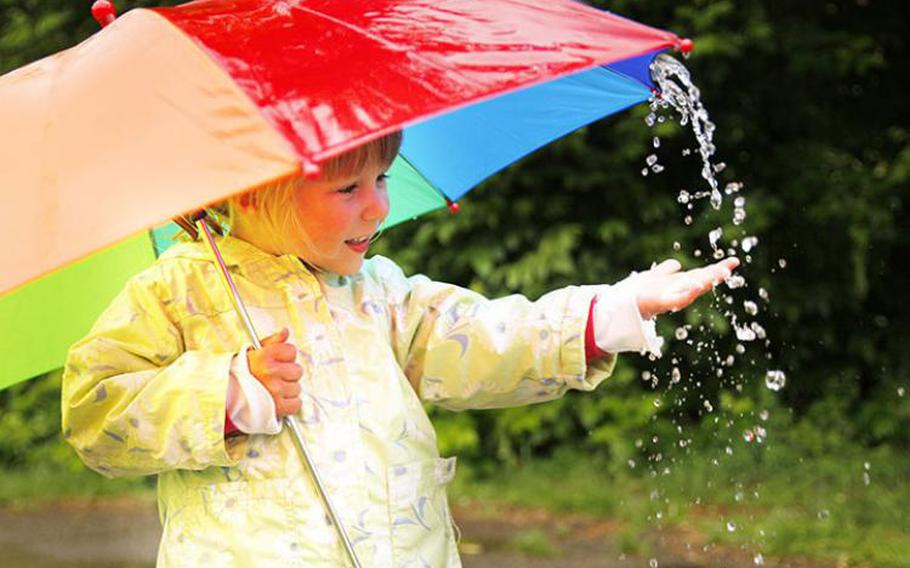Community News
Soak in Japan’s rainy season traditions
Stripes Okinawa May 27, 2024

(File photo)
Constant gray skies and gloomy showers can only mean one thing in the so-called Land of the Rising Sun: The rainy season.
It starts to fall on Okinawa in mid May followed by mainland Japan and Kyushu Island in early June. Cold northerly and warm southerly air masses collide to create 45 to 50 days of a continuous dreary weather front of clouds dropping anything from drizzle to torrential downpours.
But there’s no reason to let the bad weather get you down. Look on the bright side.
The rainy season is cheerily referred to as “tsuyu,” or plum rain, in Japan, as it coincides with the seasonal ripening of this luscious fruit. And with southern to central temperatures in the mid to high 70s (the high 60s farther north), Japan offers more seasonal outdoor activities than you can shake an umbrella at.
For starters, it’s one of the best times of the year to visit the northern island of Hokkaido. Chances are you may not even need that umbrella. Since Hokkaido is barely affected by this weather front, many locals travel there during the rainy season to escape the stifling humidity often visited upon the rest of Japan.
If you can’t make it that far north there’s still no need to resort to long weekends indoors with video games or TV. It may be the rainy season but it actually does not rain every day. (For example, the average number of rainy days in June is only 12 on the Kanto Plain, according to Japan Meteorological Agency.)
Even if it does rain, it will add a certain ambiance to your strolls along the streets of old towns and quaint neighborhoods. The rain makes old temples, gardens and traditional houses seem all the more elegant.
While out, look for cute small white ghost-like dolls made from single piece of cloth or tissue hanging from the eaves or on the windows of houses. Often children, and even some adults, make these little “teruteru bozu,” or sunshine monks, to ward off bad weather for the next day when a fieldtrip or other outdoor event is planned.
In fact, why not make your own teruteru bozu?
Also, don’t miss the opportunity to take in the beauty of seasonal foliage.
With plenty of water falling amid the early summer warmth, several pretty flowers are also in bloom this time of year. Both hydrangeas (“ajisai”) and irises (“shobu”) are in full bloom in mainland Japan, while irises and shell ginger (“gettou”) are abloom on Okinawa. Flowering shell ginger heralds the rainy season on the southern islands; hydrangeas embody the season on the mainland.
The hydrangea’s original colors can vary from white, pink, violet and blue, and they gradually shift to different colors. Some change from pink to purple, and others from blue to violet or fade in intensity throughout the course of the 4- to 6-week season.
Peak flower viewing season on Okinawa is mid-May to the end of June, while it runs from mid-June to early July on the mainland.
In Japan’s central regions firefly viewing, or “hotaru gari,” (literally firefly hunting) is another favorite rainy season pastime. Lightning bugs are active at riverside, ponds, bushes or rice fields in the humid evenings, right after it rains on windless nights without moonlight.
Countless slowly moving tiny lights filling the air and drifting from one leaf to another make a spectacular sight. But don’t catch them, as the endangered bug’s life lasts only seven to 10 days. Like fireworks festivals in Japan, “yukata” (summer kimono) and an “uchiwa” (fan) are appropriate attire for this traditional pastime.
On Okinawa, rainy season usually begins just after the Golden Week holidays that take place around late April to the first week of May, and that means dragon boat races galore. Dragon boat races are held in fishing communities throughout Okinawa. These “hari” are also known as “kaijin-sai” (unjami) or fishermen festivals; they are a way to give thanks to the sea god and pray for safe and prosperous fishing.
Memorial services on Okinawa Memorial Day (June 23) is another important event during the rainy season. Okinawans commemorate the end of the Battle of Okinawa during a big memorial service for the war dead at Itoman Peace Memorial Park every year.
So take up your umbrella and enjoy the rainy season outdoors. By walking in the rain, perhaps while singing, you just might discover attractions that are only available during this time of year.
Hydrangeas lighten up Rainy Season
If you would like to lighten up your rainy season, Yohena Ajisaien should be on the list of your next destinations. About a 90-minute drive from Camp Foster takes you to this flower garden with 300,000 hydrangea flowers and other beautiful and colorful plants and flowers. According to the staff at Yohena Ajisaien, now is the best time to view the hydrangeas. Although the flowers are expected to be enjoyed through the month of June, it depends on the weather.
Yohena Ajisaien
(Hydrangea Flower Park) Admission fee: 500 yen for adults, 200 yen for students Hours: 9 a.m. – 6:30 p.m. (Subject to change) *Free Parking GPS Coordinate: N 26.647309, E 127.945379